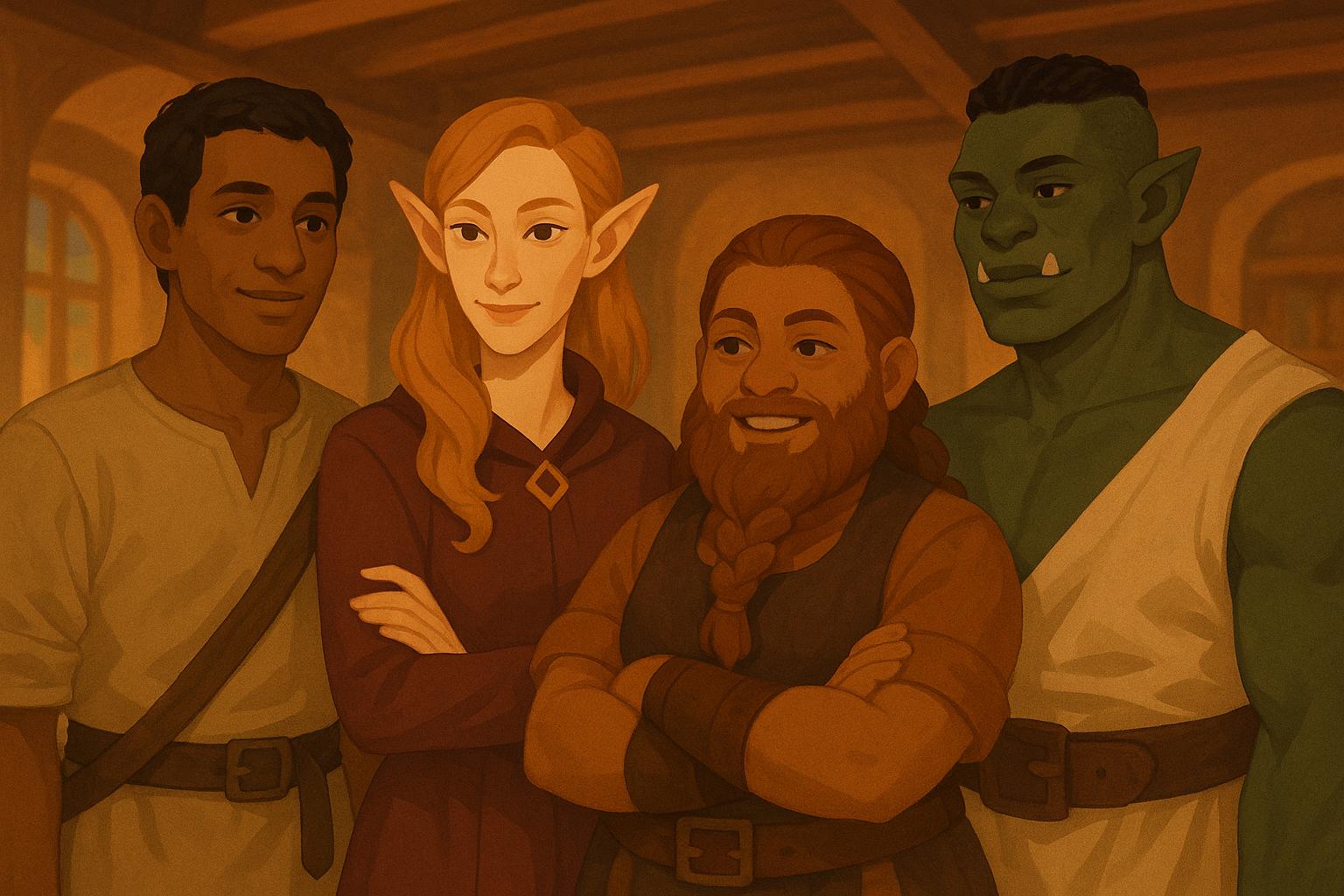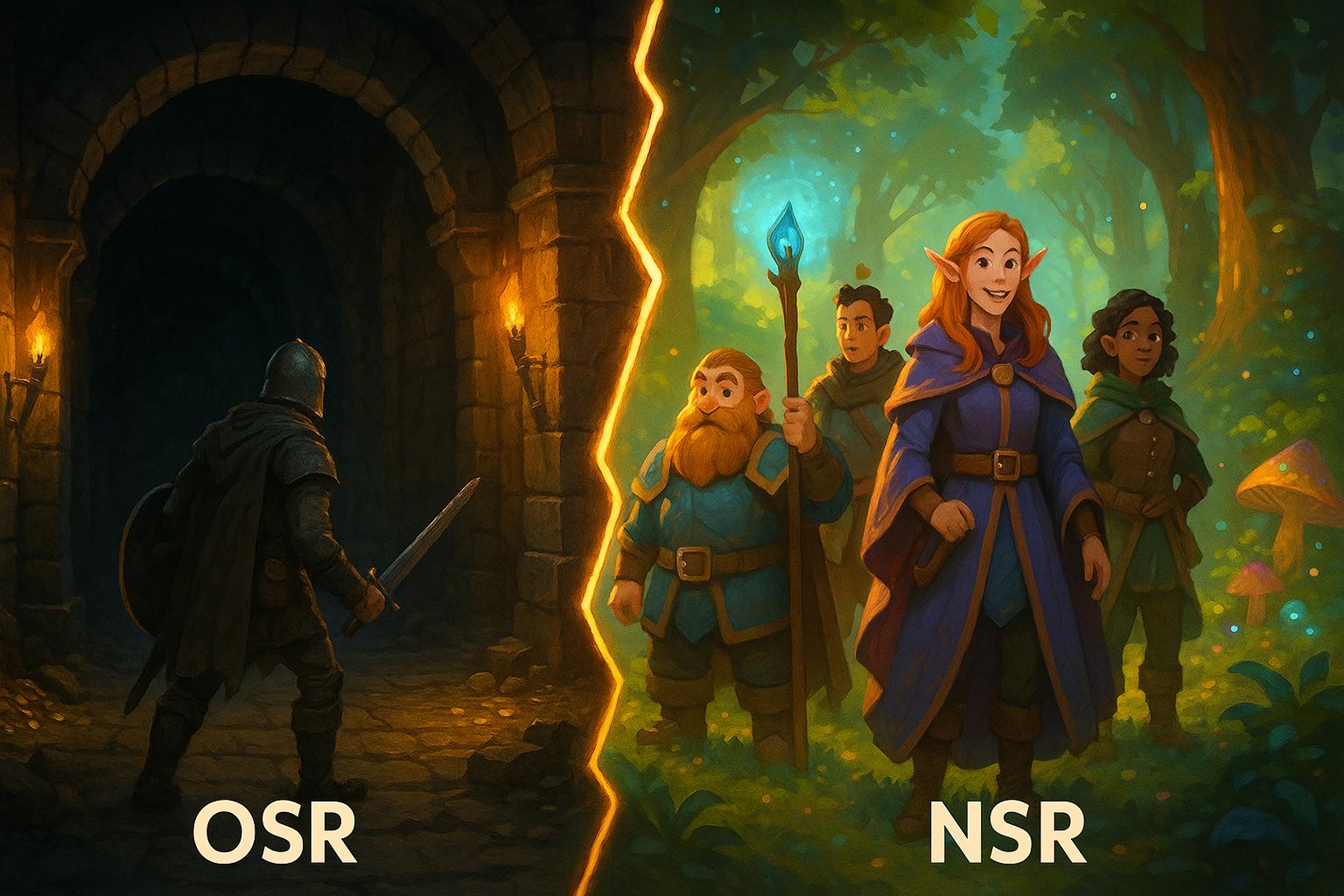Linear and parallel storytelling are two distinct ways to structure narratives in tabletop RPGs, each offering unique gameplay experiences.
- Linear Storylines: Follow a single, structured path. Ideal for focused narratives, they offer high GM control, easy preparation, and strong story cohesion. However, they can limit player choices and replayability.
- Parallel Storylines: Feature multiple, branching threads. These provide greater player agency, dynamic replayability, and deeper character impact. But they require more preparation and careful management to maintain consistency.
Quick Comparison
| Aspect | Linear Storylines | Parallel Storylines |
|---|---|---|
| Narrative Structure | Single, fixed path | Multiple, branching threads |
| Player Agency | Limited | High |
| GM Control | Strong | Requires adaptability |
| Preparation | Simple and focused | Complex and detailed |
| Replayability | Low | High |
Choose linear for structured, emotionally impactful campaigns, or parallel for open-ended, player-driven adventures. A hybrid approach can balance both styles for varied gameplay.
Linear Storylines in RPGs
Features of Linear Storylines
Linear storylines follow a set sequence of events, creating a structured narrative. The Game Master (GM) has a strong hand in steering the story, crafting key plot points that guide players through significant moments.
This approach focuses on progression with purpose. Unlike open-ended narratives, linear storylines weave a consistent thread through each session. This setup allows GMs to design interconnected events where earlier actions directly shape later outcomes, creating a cohesive and impactful experience.
Benefits of Linear Storylines
Linear storytelling comes with clear advantages for both GMs and players. The structured nature of these campaigns makes them ideal for certain types of narratives and gaming groups.
| Benefit | Description |
|---|---|
| Narrative Control | Enables carefully paced and impactful storytelling |
| Planning Efficiency | Simplifies campaign preparation and resource management |
| Story Cohesion | Events naturally build into a satisfying narrative arc |
| Session Flow | Clear direction keeps gameplay moving smoothly |
These features set linear storytelling apart from more open-ended approaches like parallel narratives.
"Linear stories have one major advantage over all other story structures: it is easy to apply traditional storytelling techniques, which have been developed over thousands of years." - Game Design Concepts [1]
Linear storylines work especially well in genres like horror and mystery. For example, Silent Hill uses controlled pacing to heighten tension and maintain its eerie atmosphere [2].
Challenges of Linear Storylines
One potential drawback of linear storylines is the risk of 'railroading,' where players feel pushed into a rigid path, limiting their sense of freedom. The challenge for GMs lies in balancing progression with player agency.
To navigate this, experienced GMs often:
- Add meaningful choices within individual scenes to give players influence.
- Create character-driven moments that tie into the main story.
- Offer side quests that allow flexibility without straying from the core plot.
- Clearly communicate the campaign's style and expectations upfront.
While linear storytelling provides structure and control, other narrative styles, like parallel storylines, offer different opportunities for creativity and player freedom.
Parallel Storylines in RPGs
Features of Parallel Storylines
Parallel storylines stand apart from linear narratives by offering multiple plot threads that unfold simultaneously. These threads are shaped by the decisions players make, creating a branching structure where stories can split, merge, or shift direction. This setup turns the narrative into something dynamic and interactive, giving players a sense of control over the unfolding events.
With this approach, players become active contributors to the story. Their choices don't just move the plot forward - they shape it in meaningful ways, creating a deeply immersive experience.
Advantages of Parallel Storylines
Parallel storylines bring unique benefits to tabletop RPGs, making them a favorite for groups looking for engaging and evolving narratives.
| Advantage | Description | Impact |
|---|---|---|
| Player Agency | Players' decisions directly influence the story | Greater involvement and connection |
| Dynamic Replayability | Branching paths encourage multiple playthroughs | Campaigns feel fresh and long-lasting |
| Character Impact | Individual choices affect the overall plot | Enhanced role-playing depth |
"Parallel storylines have one distinct advantage: they allow players to make choices that significantly impact the narrative, leading to higher engagement as players feel more invested in the story and its outcomes." [1]
Challenges of Managing Parallel Storylines
While rewarding, parallel storylines can be tricky for Game Masters (GMs) to manage. The complexity of juggling multiple branches demands extra preparation and attention to detail to keep the story cohesive without limiting player freedom.
Key challenges include:
- Increased Preparation: GMs need to plan multiple outcomes and branches, which can be time-consuming.
- Maintaining Consistency: Keeping the story logical and connected across different paths is no small feat.
To tackle these challenges, experienced GMs often rely on tools like story maps or tracking systems. These strategies help manage the chaos while keeping the narrative engaging:
- Use modular elements that can adapt to player decisions.
- Set clear narrative guidelines to balance freedom with structure.
- Maintain key story anchors to ensure the plot stays on track.
- Design flexible plot points for unexpected player actions.
Parallel storylines offer a rich, player-driven experience but require careful planning to execute effectively. This makes them a more intricate alternative to straightforward linear storytelling.
Related video from YouTube
sbb-itb-b8b00a5
Comparing Linear and Parallel Storytelling
Understanding the differences between linear and parallel storytelling helps game masters decide how to structure their campaigns. In tabletop RPGs, these choices affect both how players interact with the story and how GMs manage the game's flow.
Comparison Table: Key Differences
Here’s a breakdown of the main contrasts between linear and parallel storytelling:
| Aspect | Linear Storytelling | Parallel Storytelling |
|---|---|---|
| Narrative Structure | Follows a single, set path | Features multiple storylines running at once |
| Player Agency | Limited influence on direction | Greater impact on outcomes |
| Game Master Control | High control and predictability | Requires adaptability and quick thinking |
| Preparation Needs | Focused on one storyline | Involves planning for various scenarios |
| Story Consistency | Easier to maintain | Harder to keep all threads aligned |
| Replayability | Lower due to fixed paths | Higher thanks to branching options |
The main difference lies in how much control the GM holds versus how much freedom players have. Linear storytelling keeps the narrative tightly focused, making it ideal for delivering emotionally intense, structured stories. This approach works well for groups that prefer clear direction or for new GMs who are still mastering the art of storytelling [1].
Parallel storytelling, on the other hand, prioritizes player decisions, letting their choices shape the story’s direction [3]. While this can lead to highly engaging gameplay, it also demands that GMs stay flexible and keep track of multiple moving parts.
Linear stories are easier to plan, as they focus on a single path. In contrast, parallel narratives require detailed preparation and tools to manage the complexity [1].
"The choice between linear and parallel storytelling often comes down to balancing narrative control with player agency. Linear stories offer powerful emotional impact but less interactivity, while parallel stories provide high expressiveness but require more complex management systems." [1][3]
Replayability is another area where these approaches differ. Linear campaigns, with their fixed paths, offer limited replay value. Parallel storytelling, with its branching possibilities, encourages players to revisit the game for different outcomes [3].
A growing trend in modern tabletop RPGs is blending these two styles. Hybrid approaches combine the structure of linear storytelling with the flexibility of parallel narratives. This mix allows GMs to provide engaging stories while managing the practical challenges of running a game [1].
Understanding these distinctions enables game masters to choose - or mix - approaches that best fit their campaigns and player preferences.
Choosing a Storytelling Approach
Picking the right storytelling style for your tabletop RPG campaign depends on what your group enjoys and the goals you have for the campaign.
Factors to Consider
When deciding between linear and parallel storytelling, think about these key points:
| Factor | Linear Works Best For | Parallel Works Best For |
|---|---|---|
| Group Style | New players, structured gameplay, focused stories | Experienced players, creative freedom, open-ended exploration |
| Campaign Scope | Short adventures, one-shots, tightly focused plots | Longer campaigns, branching narratives, complex worlds |
If you're a GM who wants a mix of structure and freedom, combining these styles can give you the best of both worlds.
Combining Linear and Parallel Storytelling
A hybrid approach blends a linear main storyline with parallel elements like side quests or character-driven arcs. This setup keeps the main story on track while allowing players to make meaningful decisions that shape the world around them.
Tips for Game Masters
Session Preparation:
- Build flexible outlines for key story moments and use mapping tools to keep track of multiple storylines.
- Design plot points that can adjust based on player choices.
Player Management:
- Host a session zero to align on storytelling preferences and expectations.
- Clearly communicate the narrative structure and regularly check in to ensure players are engaged.
If you're new to parallel storytelling, start small. Add side quests to a linear main plot to gradually introduce more complexity without losing control of the primary story.
For ideas, check out the TTRPG Games Directory. It showcases games that use both linear and parallel storytelling effectively, giving you examples to learn from. By exploring different systems, you'll see how various narrative styles can be applied to your campaign.
Conclusion: Key Points
Linear storylines are excellent for delivering focused narratives with emotional weight. They offer a clear path and structure, making them a solid choice for new players or shorter campaigns [1][3]. On the downside, their fixed nature can restrict player choices and limit replayability.
Parallel storylines, on the other hand, provide a more flexible, player-driven experience. However, this approach demands extra preparation and careful oversight to keep the story threads aligned [1][3]. The decision between these styles ultimately depends on how much structure or freedom works best for your group.
Final Thoughts
As shown in the comparison table, combining linear and parallel storytelling can strike a balance between structure and player choice. Many modern RPGs emphasize giving players more control over the narrative [1]. Whether you go with a linear, parallel, or mixed approach, it’s important to consider your group’s preferences. Clear communication and adaptability are key to crafting engaging campaigns.


